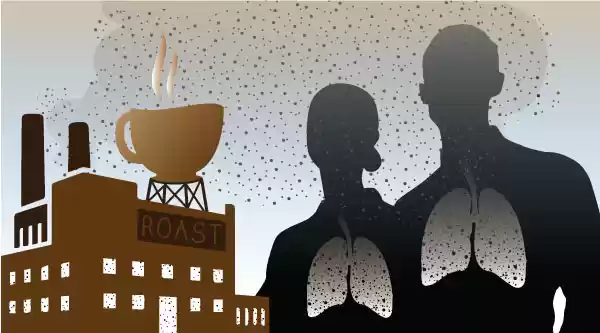
A hard cup to swallow: Is danger brewing for workers in coffee roasting plants? | Causes, Not Just Cases®
by: Motley Rice
From just a simple cup of coffee to complex espressos, flavored coffees and lattes, millions of Americans rely on their daily cup, or two . . . or four to keep them going throughout the day. However, increasing reports indicate that the behind-the-scenes work that goes into roasting the perfect cup of java may be harming workers in commercial coffee roasting facilities. The culprit? Diacetyl, a chemical compound that is released into the air during the coffee-making process and added to some flavored coffees.

Diacetyl and Workers’ Health
In 2001, the federal government agency responsible for protecting the nation’s workforce, the National Institute for Occupational Safety and Health (NIOSH), discovered a deadly new epidemic of lung disease among microwave popcorn workers.
Previously healthy workers began to have trouble breathing and suffered from a cough that wouldn’t go away. Their doctors told them they had asthma and COPD, but these doctors were wrong. Instead, these workers were suffering from a rare lung disease known as bronchiolitis obliterans. Some of these workers would go on to require lung transplants while others would tragically die from the disease.
Diacetyl, a flavoring chemical known for its buttery smell and taste, was identified as the most likely origin of the workers’ lung disease. A similar chemical called 2,3-pentanedione would later be identified as a cause of the same disease.
Since that time, NIOSH has discovered that workers in other food plants have suffered the same fate. Food flavoring workers, candy workers, snack food workers, and workers in the baking industry were all subsequently diagnosed with the same rare lung disease. All had been exposed to diacetyl. Now, 15 years later, coffee workers are being diagnosed with bronchiolitis obliterans after exposure to diacetyl that is released when the coffee beans are ground and roasted.
NIOSH says coffee workers at risk
In a 2015 article authored by NIOSH physicians and scientists, and published in the American Journal of Industrial Medicine, illustrates the morbid effects of diacetyl and 2.3-pentadedione on the respiratory system. The article interviewed and tested 75 current and former workers of a coffee roasting plant. Of the 75, six of these workers were diagnosed with bronchiolitis obliterans. The article also explains that workers who currently spend time in the coffee roasting room suffered more trouble breathing, wheezing, sinus problems, burning eyes and flu-like achiness or achy joints in the past 12 months than other workers. In addition, testing revealed high levels of diacetyl were released during the grinding of unflavored coffee beans.
The article concluded that “our finding of high diacetyl and 2,3-pentanedione exposures in the grinding of unflavored coffee beans merits consideration by clinicians seeing patients working in the coffee industry . . .”
Protecting workers should not be optional
Despite that it has been more than 15 years since the first factory workers were diagnosed with the deadly lung disease caused by the flavoring chemical diacetyl, each year sees more workers in additional industries exposed to diacetyl and then diagnosed with the same disease. Coffee and other food workers deserve to know the dangers of the chemicals they are being exposed to and the diseases they cause. The companies that allegedly expose their workers to these dangerous chemicals owe them more than just a paycheck, they owe them the truth.
NIOSH has created a coffee processing resource with interim recommendations for ways to reduce coffee workers’ exposures to these dangerous chemicals.
While currently there are no occupational exposure limits for the dangerous chemicals, NIOSH is proposing safety precautions and exposure limits. They recommend real-time air sampling to identify areas with high levels of exposure – information that will be useful when identifying exposure controls and remedies. NIOSH also recommends that employees wear fit-tested respirators and be medically supervised by means of health questionnaires, breathing tests and regular screenings. In addition they have created a Health Hazard Evaluation Program available to employers, employees and representatives offering NIOSH to investigate the workplace and make recommendations.
Despite these positive recommendations it is imperative that that dangers of diacetyl be known. I look forward to NIOSH officially regulating diacetyl exposure from natural and unnatural sources as well as food and coffee production companies taking precautions to protect their employees from harmful chemical exposure.
Authored by Scott B. Hall, a Motley Rice attorney from 2015 to 2021.